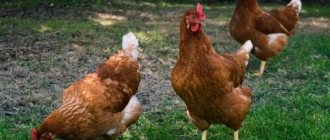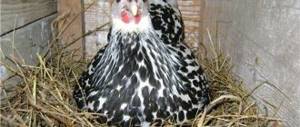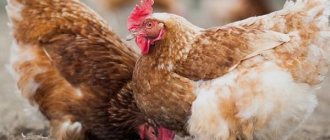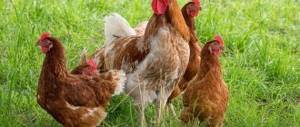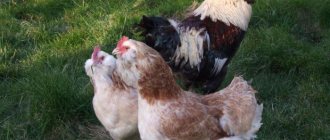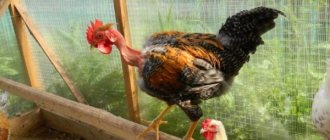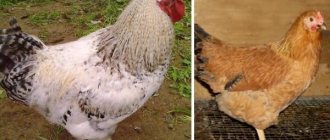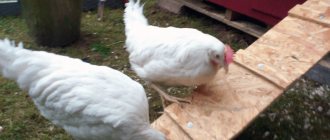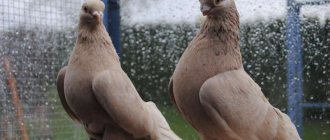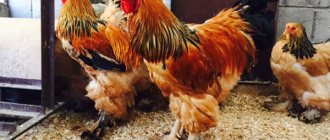Diet
This is one of the most painful points related to the maintenance of the Hungarian Giants.
The bird grows and develops very quickly, but this is achieved under proper feeding conditions. If the “Giants” diet is inadequate, the bird will begin to lag behind in development. Egg production also depends on the bird's diet. We also recommend reading: Description of the Borkovskaya Barvistaya chicken breed
It is advisable to feed chickens with starter feed until the 21st day of their life. Starter feed contains all the necessary elements for the full development of young animals.
Then the bird is transferred to a simpler diet
It is important that the poultry diet contains a large amount of protein, since it is the building material for chickens
The diet of Hungarian Giants must include:
- Wheat, corn, barley, peas.
- Fresh grass and greens.
- Sources of calcium. This can be meat and bone/fish meal, crushed shell rock, ground eggshell, food chalk.
- Mash. An important component in the diet of poultry, especially in winter. Warm mash will not only saturate the bird’s body, but will also help it warm up.
- Yeast. The bird needs them if it is significantly delayed in development.
- Fresh vegetables. Whenever possible, chickens should be given fresh zucchini, cabbage, pumpkin, etc.
Advantages and disadvantages of both breeds
These two Hungarian giants have different productive characteristics, but are otherwise very similar:
- both breeds gain weight quickly;
- do not suffer from a tendency to obesity;
- quite resistant to climatic disturbances.
The disadvantages of these chickens directly indicate their industrial purpose:
- demand for feed. With the diet of ordinary village chickens, the development of young animals stops;
- high consumption of feed.
The nuances of breeding
Due to the fact that Foxy Chick birds are quite unpretentious, they will not cause much trouble to their owners. The poultry house for the winter does not require insulation, since these individuals have thick plumage and fluff, which warms these chickens in cold weather and helps them tolerate the heat well. The main thing is that the bedding on the floor in the room is constantly changed - after all, pathogenic microorganisms multiply faster in a damp floor covering.
Despite their heavy weight, these domestic birds can easily fly to a small height - onto the lower branches of trees or onto fences. Therefore, in a fenced area, perches should be placed for them, positioning them at different heights. In addition, the fence itself enclosing the paddock must be high enough, or a roof made of metal mesh is built on top of it. This is done to prevent birds from flying outside the yard.
In winter, if there is no precipitation or strong wind, Giants can also be let out for a walk (but not too long).
Since these birds quickly increase their body weight, their feeding diet must be well balanced, because due to a lack of complete food, Hungarian Giants may develop worse and often lose weight. The productivity of laying hens also directly depends on the quality and quantity of feed.
It is better to feed chickens from birth to 3 weeks with special feed for broiler chickens, which contains all the necessary nutrients needed by young animals. In the future, it is necessary to gradually transfer the chicks to “adult” food, which should contain a sufficient amount of protein. Such food can be purchased, but you can also prepare it at home. The composition of such food should contain the following ingredients:
- 22% - wheat;
- 40% - corn;
- 12% each - peas and barley;
- 8% - remaining ingredients.
For chickens, boiled eggs are added to their diet; for older individuals, fermented milk products (cottage cheese, sour milk, whey), raw or boiled vegetables, sprouted grains, and chalk are introduced into the diet. Green grass must be present in the chickens' diet; it is given freshly cut, as well as chopped and added to the mash. Nettle is especially useful for these birds, as it contains many vitamins and minerals. This grass in winter helps Giants better withstand the cold and maintain productivity.
The diet of these large birds must contain calcium, which is necessary for the musculoskeletal skeleton and the normal strength of egg shells. Therefore, crushed chalk or shells should be added to your daily diet. Adult birds need to place containers with gravel or coarse sand near the feeders to improve the digestive process.
Description of the Hungarian Giant breed
From the outside, Hungarian Giants look like quite large birds. The body is massive and wide. However, it does not look very angular, since the lush plumage well hides the overall shape of the body. The back of the Hungarian Giants is wide, but not very large. It ends quickly, turning into a medium-sized tail. It is located at a slight obtuse angle relative to the back of the Hungarian Giant. On the tail there are medium-length braids with light round shapes.
The chest of Hungarian Giants is round and very full. The belly is just as wide and large. The wings are well pressed to the body of the bird, located at a slight angle to the back.
The head is small and expressive. The face is scarlet, there is no plumage . The eyes of these chickens are small and orange-red. The beak of these Giants is usually colored light yellow. The comb is very small even on roosters. The teeth and cutouts are faintly visible on it.
The earlobes of roosters and chickens are round in shape and light in color. Earrings of medium length, rounded. The neck of Hungarian Giants is long, set straight with a slight bend at the head. The hips are large and have lush plumage. Legs of medium length with thin bones. They have no plumage at all.
Hens differ from roosters in having a deeper chest and larger belly. They have a small tail that stands almost vertical to the ground. The comb of chickens is smaller, but stands straight.
Just by their appearance, golden Pavlova chickens win the hearts of many breeders! Beetles are very dangerous for birds! From this article you can learn how to deal with them.
As for color, both hens and roosters of Hungarian Giants are red-brown in color. Roosters almost always have a black tail and also have darker feathering on the wings and back.
Reproduction
As is the case with other crosses, only first-generation chickens obtained from Cornish and Malayan fighting cocks have unique productivity indicators. It is extremely difficult to obtain such livestock at home. But experienced poultry breeders continue the line, crossing the second generation of Redbrown with Cornish and other meat breeds, and obtain satisfactory results.
Despite this feature, chickens have a well-developed brooding instinct; they can breed offspring even without the use of an incubator. As for productivity, it drops in redbirds after reaching one year of age, which also makes their long-term maintenance and independent breeding not very profitable. When raising young animals, it is recommended to comply with the following requirements:
- temperature regime +30-32 degrees in the first days of life;
- providing protection from drafts;
- formation of a diet with a high content of vitamins and minerals;
- thorough and regular cleaning of the aviary and poultry house;
- providing walking from the age of one month; broilers should limit their mobility to speed up weight gain;
- selection of a menu with a total calorie content of about 3200 kcal per day.
Description and characteristics
One of the hallmarks of the breed is its bright red color, ranging from fiery red to reddish-brown. The body is squat and large.
Appearance
The appearance features of these chickens are as follows:
| Head | small |
| Crest | leaf-shaped |
| Beak | medium size |
| Neck | medium size, wide |
| Breast | wide |
| Stomach | wide |
| Wings | medium size |
| Tail | short, at an angle of 45 degrees |
| Paws | powerful, medium length |
| Plumage | thick |
Character
Chickens of this breed simply have a huge amount of energy, so by nature they are very active birds and keenly interested in the world around them, they love to poke around in the ground in search of food. In this regard, the birds spend a lot of time in the fresh air or in a special enclosure for walking, and the chicken coop always becomes animated when people approach.
Did you know? Foxy Chicks are excellent stepmothers: they can incubate both their own eggs and the eggs of other breeds.
Roosters, on the other hand, are aggressive and often get into fights; sometimes fights occur between hens. Nevertheless, the cockerels maintain order among their hens.
We recommend reading: Retention of placenta in cows: treatment and prevention
Advantages and disadvantages
Breeding Foxy Chick has many advantages:
- 100% survival rate among both young and adult livestock;
- rapid weight gain in chickens;
- good adaptation to weather regardless of climate zone;
- the presence of a significantly developed brooding instinct;
- unpretentious, and therefore keeping and feeding chickens does not require additional skills and/or equipment;
- high benefits due to low cost of maintenance.
With all the advantages, chickens of this breed also have some disadvantages:
- after the first year of life, productivity decreases;
- Chickens of this breed tend to show aggression.
Living conditions
Content type
When deciding where it is better to keep colored sasso broilers, in a cage or a chicken coop, you first need to decide for what purpose the bird is raised.
If it is to produce meat, then it is more rational to use cages, since in them broilers will be sedentary, which will have a positive effect on their precocity.
If it is also to obtain eggs, then it is better to place the birds in a spacious chicken coop with possible walking, for which a special pen should be made near the barn.
In this case, walking on the farmstead allows the chickens to get all the useful microelements missing in the feed, which have a positive effect on their well-being, and, as a result, increase the quality of egg production.
Planting Density
In the case of keeping colored sasso broilers in a chicken coop, it is necessary to comply with the area standards. They depend on the age of the chickens and are:
- for week-old chickens - 30 heads per 1 square meter;
- for two-week-old broilers – 15 heads per 1 square meter;
- for menstruation – 10 heads per 1 square meter;
- for adults – no more than 5 heads per 1 square meter.
If you plan to keep them in cages, then you can move chickens there only after they are one month old. 1 square meter can accommodate 15 month-old and 10 adult birds.
Environment
Regardless of the type of keeping Sasso broilers, it is necessary to take care of the environment in the room where they will live.
The air temperature inside the chicken coop should be constant, ranging from +16 to +21 degrees. To maintain optimal temperature conditions, heaters are installed in winter, and special cooling units are used in summer.
It is important to exclude the appearance of drafts, especially in the cold season. Otherwise, the chickens will begin to lose feathers and get sick.
Case is not excluded.
It is also necessary to install ventilation equipment that will eliminate the accumulation of mustiness and harmful gases: carbon dioxide and ammonia. If it is not possible to install such equipment, the number and duration of ventilation should be increased.
The humidity in the room should be 55–60%.
If broilers are kept on the floor, you need to provide them with bedding made of hay, straw or dry sawdust. Peat will also work.
How much do Hungarian giants cost?
The cost of one individual depends on the age and sex of the bird. Thus, day-old chicks are priced at 100 rubles per chick. Young animals, which are already 10 days old, cost approximately 600 rubles per individual. Roosters cost about 1,000 rubles, and laying hens cost a little more. By the way, eggs of this breed are valued at up to 100 rubles per dozen.
It is best to purchase Hungarian giants in Hungary in specialized nurseries. Chickens purchased by hand may well be half-breeds, or may have genetic diseases.
Features of maintenance and cultivation
Hungarian Giants were originally intended for breeding at home, so any poultry house with a small range is suitable for them. The yard for walking can be either green or completely earthen. You can also release birds into the garden, where they will search for grains and insects.
It should be noted that this breed is not demanding to adhere to strict temperature conditions. She feels great both in winter and summer. This property is explained by the good condition of the feather cover. For this reason, additional heating may not be provided in the poultry house. It is enough to lay a dense bedding of hay.
However, you need to keep an eye on its dryness, because pathogenic microorganisms can multiply in wet litter and have a negative impact on the health of the bird.
The only thing a farmer needs to know is that Hungarian Giant chickens must eat properly in order to gain normal body weight. They are recommended to be fed with an industrial combination feed with a high protein content. Other feeds are not suitable for chickens of this breed.
Compound feed for Hungarian Giants can be made even in a summer cottage. It should contain 22% wheat, 40% corn, 18% barley, and 12% peas.
This recipe is the most accessible, since all components are reasonably priced and can be easily found on sale. Of course, the percentage of components may vary, but with this recipe the best and most effective food is prepared.
Features of raising chickens
The chickens are in good health and their survival rate reaches 100%. Caring for them is a little different from caring for adults.
Reproduction
Since this breed is a cross, at the birth of subsequent generations the animals exhibit only individual characteristics of the breeds that were used to obtain the livestock. In this regard, it is recommended not to try to reproduce the breed on your own, but to contact farms and companies specializing in breeding Hungarian giants.
Feeding
For Foxy Chick chickens, traditional feed for meat and egg breeds is not suitable, so broiler feed is used and constant access to water is provided. It is also recommended to give the chicks a decoction, which includes a boiled chicken egg and ground grain. A couple of weeks after birth, meat and bone meal and lime additives are added to the food, and after a month and a half, the chicks are transferred to normal nutrition.
Did you know? Chickens are very good at time navigation and are able to remember more than 100 human faces.
However, the grind should be finer than for adults. It is especially worthwhile to ensure the cleanliness of the drinking bowl and constant change of water.
Caring for young animals
The basis of caring for chicks is control of nutrition and food. For the first two months of life, the water should be no colder than 40 degrees, and the food should not contain grain, since the chickens are unable to digest it and their stomach will become upset. Since hens have a well-developed maternal instinct, no additional control over the chicks is required.
Description and standards of the Hungarian giant
The name of this breed contains key information - the origin and the main characteristic of productivity. The Hungarian giant differs from ordinary laying hens in its impressive size and weight. In order not to buy ordinary chickens instead of purebred ones, it is useful to familiarize yourself with the characteristic features of the breed in advance.
Exterior
The giants are indeed very large, they have a massive body, as befits the descendants of Cochins and Orpingtons. Having a small stature, the bird seems squat.
Characteristic features of the exterior:
- The carcass is square and barrel-shaped.
- The chest and abdomen are clearly defined.
- Legs – powerful, yellow, without down.
- The wings are powerful, tightly pressed to the body.
- The skeleton and muscles are well developed.
- The plumage is reddish-red, especially lush on the hips and keel.
- The feathers are hard, with a warm layer of down.
- The tail - in females it is small, but in roosters - is clearly visible and colored black.
- The head is neat, with a small beak rounded at the edge.
- The neck is elongated and powerful.
- The comb is round and bright red.
The Hungarian giants got their thick plumage from the Orpingtons, and those from the Cochins.
Temperament
It is difficult to describe in a few words the character of this breed. Hungarian giants are typical chickens, with all shades of a “chicken” character - they are cheerful, restless and curious. However, they do not cause any particular problems for poultry farmers. Compared to many other breeds, giants behave quite decently.
Only roosters have a quarrelsome and quarrelsome disposition. They actively defend their territory and “harem”, so it is not advisable to keep several roosters in a small flock. But, compared to many other breeds, giants are not aggressive; they are able to get along in the poultry yard with various living creatures.
The restless nature of this breed is taken into account when arranging a chicken coop. Everything is organized with maximum safety, the partitions are made high, the nests are wide, the perches are low (up to 0.5 m).
An overview of the Hungarian Giant chicken breed is presented in the following video:
Puberty and egg production
Like all meat and egg breeds, giants are balanced in terms of egg production - they are not record holders for laying eggs, but they cope well with the tasks of laying hens. Laying hens begin laying eggs at 4-4.5 months. The first eggs are medium-sized, with a light brown, medium-density shell.
While egg production is improving, the eggs may have defects - this is due to calcium imbalance in the young body. The hens then lay larger eggs.
Hatching instinct
Chickens of this breed have a well-developed hen instinct. They sit responsibly and calmly on the clutch, without subjecting future chicks to tests - they do not go away for a long time, and vigilantly monitor the temperature of the hatched eggs.
The hen turns the eggs herself to ensure uniform heating. When the chicks are born, the hen takes care of their safety, accompanies the brood everywhere, and protects it if necessary.
One hen can hatch 10 eggs at a time. Survival rate during natural hatching is almost 100%, which confirms the high quality of hatching. The poultry farmer's task is to feed the hen better. In the process of sitting on the masonry, her body is exhausted.
Advantages and disadvantages
Advantages of the Hungarian giants:
- high weight and high meat yield;
- high productivity of meat and eggs;
- easily adapts to different climates;
- the brooding instinct is well developed;
- healthy offspring;
- high survival rate;
- rapid weight gain;
- fairly large eggs;
- high – for meat and egg breeds, egg production;
- high immunity;
- resistance to temperature changes;
- precocity.
Compared to this list of advantages, the disadvantages of giants seem insignificant:
- short duration of egg production - the chicken lays eggs for about a year, then it is used for meat;
- with irrational feeding, a tendency to obesity appears;
- demand for feed.
In general, the breed has much more advantages, which is why it has maintained its popularity for so long. These chickens, without requiring special housing conditions, reproduce quickly and easily, no worse than rabbits.
Pros and cons of the Hungarian Giants
The bird of this breed has managed to prove itself mainly on the positive side. But, like all existing breeds, “Giants” are not without their drawbacks.
Among the advantages of Hungarian chicken are noted:
- Fast weight gain.
- Despite its gluttony and rapid weight gain, birds of this breed do not have a tendency to gain fat mass.
- The chicken has a fairly good immune system and is not afraid of low temperatures.
As for the disadvantages, the disadvantages of the Hungarian ones include:
- High gluttony.
- The diet of the “giants” must be complete, otherwise the young animals will lag behind in development.
What to feed?
Laying hens are generally unpretentious in their maintenance and diet, so they can eat any food that grows under their feet. But a menu rich in various minerals and vitamins will help birds maintain their health for as long as possible and ensure high productivity.
Chickens
Gilan chickens have innate immunity to many diseases, so the chickens are born strong and large. The survival rate of young animals is approximately 95%. To ensure that babies grow healthy and strong, feed them for the first time no later than 12 hours after birth.
For the first three days, the diet of young animals consists of a mixture of boiled eggs and cereals in the form of millet or barley; also add oat flakes or low-fat cottage cheese to the mash. Finely chop all the ingredients and give it to the kids warm.
Then gradually add greens and vegetables to the menu. For example, excellent options include nettle, clover or alfalfa. Vegetables can be beets, carrots and pumpkin. Pour boiling water over the greens in advance and chop them into small pieces; boil the vegetables and mash them into porridge.
In the 1st week of life, chickens should receive dishes made from grains, herbs, vegetables and boiled eggs. In the 2nd week, add fish or bone and meat-bone meal to the menu.
It is mandatory to have clean and fresh water so that children can quench their thirst. Add a little potassium permanganate to the water; this product will help protect young animals from harmful insects and diseases. By the end of the 1st month, the chicks can be transferred to the diet of adult chickens, which contains large amounts of protein and calcium.
Adult herd
Feed adult individuals no more than 3 times a day, 2 times - grain mixtures, 1 - wet mash. You should carefully select the menu for birds so that they receive all the important elements. You can feed mixed foods high in protein. In general, chickens eat any food intended for this type of bird.
The diet of Gilan adult chickens consists of:
- grains: wheat, oats, corn, rye or barley;
- fresh greens and grass, which help restore the balance of vitamins in birds;
- in winter you can do without greens, but then add sprouted grains to your diet;
- maggots, cake and meal;
- bone and fish meal;
- crushed shell or fine gravel;
- crushed egg shells, crushed bones, which not only improve the functioning of the gastrointestinal tract, but also compensate for the lack of vitamins in food.
One of the most important nutritional requirements for Gilan birds is compliance with the diet and portion size. After the chickens eat, remove any leftover food, otherwise the birds will begin to accumulate excess fat, which will negatively affect the productivity of the birds.
Hungarian giant chicken breed: description and characteristics, maintenance and care
The goal of the poultry farmer is to get the most productive farm possible. In many ways, the overall profitability of a poultry farm depends on the choice of breed for breeding. Here, Hungarian breeders made a real gift to farmers, introducing the Hungarian Giant chicken breed to the world.
These birds are distinguished by good egg production rates and rapid gain of muscle mass, which is a record for laying hens. At the same time, giants are perfect for beginners who have no experience in breeding breeds, because they are unpretentious in care.
Our article will tell you about all the features of the type and the subtleties of its content.
Breed characteristics
When choosing a breed of any animal species, you must carefully read the characteristics and accurate description.
Firstly, such a detailed approach will help you not to make a mistake and get a productive poultry farm in the direction you have chosen (Hungarian is suitable for meat and meat and eggs).
Secondly, knowing the standards of appearance of Hungarian giants, you can be sure of the purebred and health of your newfound birds.
When examining, be careful, this breed can easily be confused with the Magyars or the “Master Grey”.
Appearance and standards
At first glance, the Hungarian giant is no different from a simple mongrel laying hen, of course, if you do not take into account the size and weight of the body. Adult roosters reach a weight of 5 kg, and hens - 4-4.5 kg! Distinctive features of the breed are:
- a large, powerful body of a rounded shape, reminiscent of a barrel, with a clearly defined chest and tummy. At the same time, the birds are small in height, which makes them squat;
- the skeleton and muscles are well developed, the legs and wings are powerful;
- dense plumage of a reddish-red color, especially lush on the hips and keel. The feathers are hard with brightly drawn braids and a warm layer of fluff;
- the tail of females is reduced, while that of roosters is well defined and black in color;
- a small, agile head with a neat beak rounded towards the tip;
- comb, earrings are weakly expressed and flaccid, bright red in color.
Due to their fox coloring, Hungarian giants are sometimes called “Foxy Chicken”, which literally translates as “fox chicken”.
Character
Hungarian giants are real fidgets. A distinctive character trait of these birds is their cheerfulness, restless curiosity and inability to sit still. This brings a little difficulty in organizing the chicken coop; everything should be as safe as possible.
You will have to install high partitions, wide nests, perches at a level no higher than 0.5 meters and be careful with the front door, these chickens will not miss the opportunity to run out into the yard. During the summer, Hungarians need exercise to keep them fit and healthy.
Another disadvantage of this nature is the aggressiveness of males during the mating season, but this problem is solved by separating males (no more than 1 rooster per pen and 6 hens). Find out about the description of the Minorca chicken breed here.
Origin
The homeland of the breed can be guessed by its name - it is Hungary. Local breeders have set the task of increasing the productivity and reducing the maturation time of ordinary village laying hens. The basis for crossing was the Orpington breed, popular in Europe.
The process took quite a long time and the hybrid saw the light of day less than half a century ago. The scientists’ efforts were rewarded with the wild success of the Hungarian giants among poultry farmers around the world. At exhibitions the species was presented as the “Red Broiler”.
Read about the maintenance and care of the Amrox chicken breed at this link.
Advantages and disadvantages
The Hungarian Giant breed has many advantages:
- huge body mass for birds;
- yield of pure lean meat is about 60%;
- high egg production and large egg sizes;
- developed maternal instinct;
- strong immunity, ability to resist viruses;
- resistance to temperature changes;
- precocity.
A serious advantage of the Foxy Chick cross is the 100% survival rate of hatched chicks.
This list is enough to make a choice in favor of a red broiler. The disadvantages may seem insignificant. These include a short period of egg production - only a year. However, this fact is smoothed out by the early start of clutches. And after a year, you will receive a large, heavy carcass, which will also have a positive effect on the profitability of the farm.
Productivity
The Hungarian giant belongs to the meat and egg breeds and shows high results in both areas.
Carcasses show record performance; one bird produces an average of 3.5 kg of clean meat, distinguished by excellent taste. The age of slaughter of roosters is 4-5 months.
Laying hens lay eggs for 12-14 months, after which they are also sent to slaughter. The meat of laying hens, even at one year of age, does not become tough or fatty.
The egg production of red broilers is average; one hen produces about 180-200 eggs per year, which have a strong pinkish-brown shell. The weight of one egg ranges from 55 to 100 grams, depending on the conditions and diet of the chicken. These chickens mature quickly, the first clutches appear already by 4 months of life. Read about the characteristics of the Brown Nick chicken breed here.
For incubation and subsequent breeding, it is customary to choose even, medium-sized eggs, up to 60 grams.
Hatching eggs
Female Hungarian giants are very attentive to their offspring. Their hatching instinct is remarkably developed, thanks to which farmers with small herds can do without an incubator.
Moreover, in addition to hatching, Hungarian women also carefully approach the issues of raising chicks and take care of them for a long time.
Because of this behavioral feature, keeping birds of this breed requires comfortable, spacious nests where the hen could breed offspring.
and care
Choosing a productive breed is only half the battle. In order for birds to bring you a large number of eggs and meat products, the conditions under which they are kept are important.
The main factors influencing egg production and weight gain are the feeding regime and composition, arrangement of the chicken coop and temperature and climatic parameters.
Let's consider what requirements the Hungarian giant chicken places on the farmer.
Feeding
The whole process is conventionally divided into fattening the chicks and feeding the adult flock. The first stage is short, approximately 2-4 weeks. During this period of time, the diet does not differ from the diet of any other breeds and consists of:
- boiled egg;
- millet;
- low-fat cottage cheese;
- fishmeal;
- starting from week 2, combined mixtures are introduced;
- vitamin and mineral supplements.
Adults need nutritious and high-calorie foods. Compound feeds of the standard start-grow-finish system are best suited.
Remember that heavyweight birds require food high in protein and minerals, this is important for skeletal formation and muscle gain.
In addition to compound feed, the diet of adult livestock includes granulated grass meal, meat and bone meal, dry skim milk sludge, vitamin and mineral complexes. In the summer, half of the diet is replaced with succulent pasture for walking.
Climate
A significant advantage of Hungarian auras is their innate resistance to cold and changes in climatic conditions.
Chickens of this species, like Foxy Chick, easily tolerate frosts down to -20 degrees. When the temperature drops to -10 degrees, short-term walking is possible.
However, they need a warm, draft-proof coop. Warm boxes are needed only for chicks and young animals up to 1 month old.
Due to its thick plumage, the red broiler does not require intensive heating.
Walk
Walking is necessary for Hungarian women to maintain physical fitness and proportional muscle development. For walks, organize a spacious courtyard, the area being approximately 2 times the area of the chicken coop.
The height of the fences (we construct them from wooden crossbars and metal mesh) must be sufficient, at least 1.5-2 meters, otherwise the chickens will fly over it.
In the spring, it is recommended to sow the walking area with grains (oats or wheat) or herbaceous plants, this way you will provide the birds with green food. Find out about breeding Rhodonite chickens in this article.
Chicken coop
Since these are large birds, the area of the finished chicken coop should be large. Distribute the territory so that no more than 1-2 individuals live on one square meter. It is also not recommended to place more than 1-3 roosters in one room. The floor covering can be earthen or concrete; a bedding of straw or sawdust is required.
https://www.youtube.com/watch?v=sb2DaAmCvxg
This breed needs perches, because, despite their considerable weight, Hungarian giants fly well
Heavy giants find it difficult to climb high perches.
The poles for them must be strong and located no higher than 0.5 meters. It is also possible to keep birds on the ground without perches. What is necessary is the construction of nests and the arrangement of a ventilation system.
Lighting is necessary only in winter for 10-12 hours a day.
Breed Features
Breeds of animals and birds have many characteristics inherent at the genetic level.
Such specific features include the stability of the name system, interruptions in productivity at different points in life (in one case, the cessation of egg production is the norm, in another it may be evidence of pathologies). These characteristics should be taken into account no less carefully than basic data about the breed.
Molting and break in egg laying
Under normal conditions, chickens lay eggs every day. But with the onset of seasonal molting, which lasts from 1 to 2 months during transitional seasons, egg production decreases and sometimes stops altogether.
This is due to the body’s transition to a new light regime and day length. After molting, clutches resume, the number of eggs often exceeds the original.
It is important to maintain a nutritious diet during low egg production and not to change the care regimen for molting birds.
Molting in birds occurs after the end of the breeding period.
Frequent illnesses
Farmers love Hungarian giants for their strong immunity; poultry farmers practically do not complain about diseases among this breed. However, minor problems arise and are associated in most cases with dense plumage, where parasitic blood-sucking insects can live.
To avoid such troubles, you should conduct a thorough inspection of the livestock 1-2 times a month, and carry out monthly disinfestation of the premises. Despite their stable health, young animals are recommended to be vaccinated against the most dangerous diseases, such as salmonella or infectious bronchitis.
This material will tell you about Phoenix chickens.
This video provides a detailed overview of the Hungarian Giant chicken breed.
conclusions
- Hungarian giant chickens have gained recognition not only in their European homeland, but throughout the world due to their high rates of meat and egg production.
- Red broilers have a record size for poultry - their weight exceeds 4 kg.
- An important advantage of Hungarian chickens is their unpretentiousness to living conditions, as well as strong immunity and well-developed maternal instinct.
- The specifics of keeping boil down to increasing the nutritional value of the feed and the mandatory arrangement of a pen for walking in the summer; otherwise, the breeding of these birds is not much different from the Russian White, Rhode Island and other representatives.
Diet
This is one of the most painful points related to the maintenance of the Hungarian Giants. The bird grows and develops very quickly, but this is achieved under proper feeding conditions. If the “Giants” diet is inadequate, the bird will begin to lag behind in development. Egg production also depends on the bird's diet.
It is advisable to feed chickens with starter feed until the 21st day of their life. Starter feed contains all the necessary elements for the full development of young animals.
Then the bird is transferred to a simpler diet
It is important that the poultry diet contains a large amount of protein, since it is the building material for chickens
The diet of Hungarian Giants must include:
- Wheat, corn, barley, peas.
- Fresh grass and greens.
- Sources of calcium. This can be meat and bone/fish meal, crushed shell rock, ground eggshell, food chalk.
- Mash. An important component in the diet of poultry, especially in winter. Warm mash will not only saturate the bird’s body, but will also help it warm up.
- Yeast. The bird needs them if it is significantly delayed in development.
- Fresh vegetables. Whenever possible, chickens should be given fresh zucchini, cabbage, pumpkin, etc.
Content Features
The specifics of raising broilers at home do not require significant effort from poultry farmers
It is only important to remember that representatives of the Redbrown breed need a spacious chicken coop with a full-fledged walking aviary. There is no need to create perches inside - due to their short wings, birds cannot glide or fly, but they may well be injured if they fall from a height
Inside the chicken barn, a warm space with thick bedding is provided to prevent drafts, as well as sufficient ventilation to maintain optimal humidity levels. The minimum room temperature, even in severe frosts, should not drop to +6 degrees. Nests are built inside for laying and incubating eggs.
Diet
A properly formulated diet is the basis for good growth and development of redbreasts. The volume of feed depends solely on the conditions of detention. With a cage-free lifestyle, broilers should receive food 3 times a day. Birds with access to free movement are fed twice a day, without adding significant amounts of vitamins. They get all the necessary nutrients from pasture.
For birds living in a chicken coop permanently, it is recommended to include grass and pine flour and baker's yeast in their diet to prevent vitamin deficiency. 4-5 times a week it is worth giving broilers warm mash of meat or fish broth
It is important that the diet be varied; this directly affects body weight gain and egg production. It is useful to include berries and fruits, tops of root crops in the diet
Hygiene
Redbred chickens are quite demanding when it comes to ensuring their hygiene needs. Pets need to replace the top part of the bedding weekly, and the entire bedding once a season. Simultaneously with the big cleaning in the spring, the poultry house is completely whitewashed with slaked lime. Birds fight skin parasites themselves using ash-sand baths. Be sure to install 1 container for 2-5 birds. Once a quarter, external treatment for skin parasites is carried out for preventive purposes, and deworming is also performed.
Necessary equipment
To keep redbred chickens, it is necessary to purchase feeders and drinkers that are deep and voluminous enough to ensure saturation of the birds. In addition, you will need to purchase cages if you plan to raise poultry for meat purposes.
Productivity
The Hungarian giant belongs to the meat and egg breeds and shows high results in both areas. Carcasses show record performance; one bird produces an average of 3.5 kg of clean meat, distinguished by excellent taste. The age of slaughter of roosters is 4-5 months. Laying hens lay eggs for 12-14 months, after which they are also sent to slaughter. The meat of laying hens, even at one year of age, does not become tough or fatty.
The egg production of red broilers is average; one hen produces about 180-200 eggs per year, which have a strong pinkish-brown shell. The weight of one egg ranges from 55 to 100 grams, depending on the conditions and diet of the chicken. These chickens mature quickly, the first clutches appear already by 4 months of life. Read about the characteristics of the Brown Nick chicken breed here.
Hatching eggs
Female Hungarian giants are very attentive to their offspring. Their hatching instinct is remarkably developed, thanks to which farmers with small herds can do without an incubator. Moreover, in addition to hatching, Hungarian women also carefully approach the issues of raising chicks and take care of them for a long time. Because of this behavioral feature, keeping birds of this breed requires comfortable, spacious nests where the hen could breed offspring.
This is interesting: Maslenitsa - 7 best pancake recipes by day of the week
Feeding
But this point is the most painful for the Hungarian giants. They must receive adequate food, otherwise their growth will be stunted. And the egg production of laying hens also greatly depends on the quality of feed.
It is advisable to feed young animals up to twenty-one days with starter feed for broilers, which contains everything necessary for proper nutrition and growth. Then gradually switch to other types of feed, ensuring sufficient protein content. The food can be either factory-made or home-made. The best composition, tested by generations of poultry farmers:
- wheat – 22%;
- corn – 40%;
- barley – 12%;
- peas – 12%;
- other components – 8%.
Desirable additives include eggs (for chickens), cottage cheese, whey or sour milk, chopped boiled or raw vegetables, sprouted grains, chalk. Grass can be given to birds either freshly cut or chopped and added to mash
Particular attention should be paid to nettle, which is rich in vitamins. In winter, it will help both to survive the winter better and to maintain egg production.
Since giants, according to the characteristics of the breed, are large birds, care must be taken to ensure that they receive a sufficient amount of calcium in their food. To do this, it is advisable to keep chalk and crushed shells in the chicken coop. You can dust the top of the mash with chalk. For chickens, add calcium gluconate in ampoules to their drinking water several times.
Chickens should have plenty of gravel or coarse sand. They swallow it to grind and grind food in the stomach. If there are not enough pebbles, then most of the feed will not be processed.
Currently, breeders are working to improve the Hungarian Giant breed in order to obtain a bird that is less demanding on the quality of feed. If this succeeds, you will get ideal chickens.
Breeding Foxy Chick chickens at home
The Hungarian is an extremely unpretentious breed and does not require special treatment. However, she still needs basic amenities.
Find out who mini meat chickens are.
Suitable conditions
Let's consider which chicken coop is most preferable for chickens.
Chicken coop requirements
The chicken coop should be spacious, since chickens are very energetic; the area is calculated using the formula 3-4 chickens per 1 square meter. m. The entire structure should be closed, since chickens fly well. Perches with nests and perches are placed at a height of 80 centimeters from the floor and have a diameter of 4 centimeters. The floor is covered with insulation, which can be used as hay, straw, peat, dry leaves and sawdust.
The chicken coop is equipped with a bath of ash and sand, in which the chickens clean their plumage. The chicken coop should be free of moisture and dampness to prevent the development of mold and harmful microorganisms.
Important! The use of polystyrene foam is strictly contraindicated - chickens will peck at it out of habit, dooming themselves to intoxication and a clogged crop.
Feeders and drinkers
Drinkers and feeders are located inside the chicken coop. They must be closed to prevent the entry of germs and insects that will spoil the food and/or parasitize the chickens.
Walking yard
There should be a courtyard on the south side of the chicken coop where the chickens can roam. The courtyard is connected to the chicken coop using manholes that are open all year round. In winter, these holes are covered with wood to protect the chickens from the cold. Keeping in mind Foxy Chick's ability to fly, the courtyard is equipped with a fence up to 1 meter high.
Important! Chickens tolerate cold well, so in winter you should refrain from walking only if the frost is stronger than 10 degrees.
Feeding adults
Almost everything goes into Foxy Chick food. The diet should be based on a lot of cereals and legumes - peas, barley, corn and wheat. Mash and mixed feed with pieces of chopped herbs and foliage - clover, alfalfa and nettle - are good food. Suitable mixtures include fermented milk products, meat and bone meal, and fish oil. A mixture of crushed shell shells and eggshells is also added to the food - they will help the chicken grind the food. It is worth feeding animals 4 times in the warm season and 5 times in winter.
Molting and break in egg production
Like other chickens, Hungarian Giants molt seasonally. It occurs in the fall and lasts from 6 to 8 weeks. During this period, chickens stop laying eggs. Shedding can be accelerated by eliminating grain from the diet and reducing the amount of sunlight. The egg production of these chickens is year-round, but from the second year it is significantly reduced, and therefore one-year-old chickens are slaughtered.
We recommend reading: Description of the vanilla plant: what the fruit looks like (with photo)
How to care for chickens?
Buying a productive breed is half the success. To get maximum profit from a bird, favorable conditions are created for it:
- a properly equipped chicken coop with walking;
- complete feeding in accordance with the regimen;
- maintaining normal temperature and climate indicators.
Climate and walking
The breed is characterized by increased resistance to temperature changes and cold. What you need to know:
- tolerate frosts down to minus 20 °C without problems;
- Chickens are allowed outside if the frost is not lower than minus 10 °C;
- on frosty days, walking is short-term.
To maintain good physical shape, Hungarian women are walked outside - they set up a special fenced yard. Features of the walking yard:
- the walking area is approximately twice the area of the chicken coop;
- the fence is made of wooden blocks and metal mesh;
- fence height – 1.5-2 m;
- In the spring, the walking area is sown with wheat, oats or grass so that the birds have green food.
The breed, thanks to its thick and dense plumage and excellent adaptive abilities, tolerates all natural disasters well - heat, frost, high humidity. High-quality feather cover, like an Uzbek robe, protects giants from cold in winter and from heat in summer.
Setting up a chicken coop
Red broilers have thick feathers, so they can live in unheated chicken coops - if the winter temperatures of the region correspond to the frost resistance of the breed. Giants are kept in insulated chicken coops, protected from drafts. Warm boxes are necessary for young animals up to 1 month.
Rules and features of arranging a chicken coop for Hungarian giants:
- Giants are a large breed, therefore, per 1 sq. m should be home to no more than two individuals.
- There should not be many roosters in one room to avoid fights. Maximum – 1-3 pieces per chicken coop. Males fattened for slaughter can be kept in cages, without walking.
- The floor is earthen or concrete.
- There must be bedding on the floor - straw, hay or sawdust. The litter is turned periodically and fresh is added as needed.
- It is desirable to have perches. Perches are arranged taking into account the large weight of the birds - it will be difficult for them to fly to a height of more than half a meter. Possible maintenance without perches.
- There should be drinking bowls in accessible places, always filled with clean water. You can learn how to make a drinking bowl with your own hands from this article.
- In winter, lighting is necessary - for 10-12 hours a day.
Before introducing a new flock into the chicken coop, it must be disinfected. The bedding is changed and the floor is sprinkled with slaked lime. People enter the chicken coop wearing a change of shoes to avoid spreading germs.
Molting and break in egg laying
All hens have a period during which their bodies rest from continuously laying eggs. The pause is associated with seasonal molting - it begins in the fall, when the hormonal background of chickens changes due to a decrease in daylight hours. Loss of plumage is also associated with vitamin deficiency, stress and metabolic imbalance.
Seasonal molting lasts about two months. After this period, the molting ends and the clutch returns. Often chickens lay eggs even more intensely than before molting.
Loss of feathers may indicate a parasite infestation. The poultry house must be regularly disinfected, and the laying hens must be treated with insectoacaricides.
Planned herd replacement
One of the disadvantages of the Hungarian giants is the short duration of the masonry. As soon as the peak of egg production passes, the hens are sent for meat. The most productive period is one year from puberty. Next year, the number of eggs laid decreases by about a quarter. By this time, it is necessary to prepare replacement hens.
When raised for meat, poultry is slaughtered at 3-4 months of age. After this age, their weight remains almost unchanged, and the meat only deteriorates over time. The cost of poultry increases, profits fall. It turns out that every 3 months it is necessary to update the meat stock.
If chickens are raised for meat, then the first batch of eggs is laid in February. In March, the chickens grow up in a nursery, and in April - in a chicken coop with a free range. The next laying is planned so that a continuous cycle of meat reproduction is obtained.
Maintenance and care
The unpretentiousness and endurance of Hungarian birds has made them mega popular, especially among poultry farmers living in regions with harsh climates. But, you still need to know something about their content. Let's look at the basic rules.
Climate
Unlike other species, the red broiler has an innate resistance to cold and frost, and can easily adapt to any climate. Frosts are not scary for the winged family if you properly insulate the room in which it lives.
Walk
For these birds it is necessary to organize a spacious courtyard in which they can be active. In the spring, you can sow grass or cereal crops to get green shoots for black cockle. A small fence is required, as Hungarians do not fly high.
Chicken coop
Taking into account the fact that Hungarian giant chickens are not small, they need a spacious room, and preferably without perches. Choughs are not able to climb high perches, and for this reason floor keeping is recommended.
The area should be ventilated, clean and dry to avoid unnecessary health problems. The poultry house must be equipped with nests for active laying hens. Consider intermittent lighting for the winter.
Molting and break in egg laying
Despite the fact that laying hens lay eggs every day, there comes a period in their lives every year when they take a break. This is due to the onset of seasonal molting, which most often happens to them when the length of daylight hours decreases in the autumn.
After this natural process is completed, the masonry is restored, and sometimes even strengthened. The duration of seasonal molting, as a rule, is no more than 2 months.
Planned herd replacement
Hungarian broilers are not productive in laying for very long, and after a period of maximum activity they are sent to slaughter. The most fruitful period is the first year after puberty. Next year the number of testicles will decrease by 20-25%.
Frequent illnesses
Poultry farmers know that broilers are the most problematic in terms of health. But the hen in question is not considered a problem hen, even though she is also called that.
Feathered beauties Hungarian giant chickens, when provided with basic care and good nutrition, do not experience health problems. The disease does not affect winged flocks, but prevention is needed. Survival rate among young animals and adults is 98-100%.
What are the reviews?
Feeding
In order for colored broilers to grow well, not get sick and produce a lot of meat/eggs, they must be fed properly - this is one of the most important conditions that cannot be ignored.
The best option for feeding birds that you are raising for meat is commercial prepared feed. Usually they initially contain all the necessary vitamins and microelements that the body of young individuals requires. They already calculate all the necessary proportions and number of calories.
Of course, you can prepare a balanced diet for colored broilers yourself. To do this you need to use the appropriate components:
- 90-100 g of oatmeal;
- 390-410 g cornmeal;
- 45-55 g derti barley;
- 190-205 g wheat derti;
- 1.5-2.5 g baker's yeast;
- 150-180 g cottage cheese;
- 55 g bone or fish meal;
- 140-145 g sunflower cake.
All of the listed components will need to be thoroughly kneaded. The resulting food should be given to the birds in accordance with their age, 10-20 g per bird.
To make the birds' skeletons stronger, they need to be given more calcium. To do this, the broiler should be fed eggshells, chalk or shells. These components contain a large percentage of calcium.
Birds, especially young ones, also need various vitamin supplements.
Before serving food to colored broilers, it is recommended to warm it up a little. You cannot feed individuals rice, buckwheat or other cereals in a raw state. Do not neglect these prohibitions if you do not want to cause serious harm to your poultry.
Reproduction
To obtain hatching eggs, Hungarian Giant hens are crossed with Orpington or Rhode Island roosters. This method has a serious drawback, since newborn chickens lose the characteristic characteristics of the breed. Most poultry farmers prefer to buy eggs from farms or large farms, but there are some nuances here - most often, crossbred eggs that do not give the declared indicators are sold. You can only get “pure” breed chickens by purchasing eggs in Hungary, which is not available to all farmers.
Hungarian giant brood hens happily hatch eggs and take care of the chicks
For the purpose of breeding birds, it is better to leave one medium-sized rooster. Large males not only do not always pass on their characteristics to their offspring, but can seriously injure laying hens. To prevent the rooster from injuring the backs of the hens, it is recommended that he trim his claws or put special blankets on the backs of the females.
Advantages and disadvantages
Reviews from owners about the breed are very flattering, and not by chance, since Hungarian giants have much more advantages than disadvantages.
The strengths of the bird include:
- high productivity;
- precocity;
- unpretentiousness;
- cold resistance;
- external attractiveness;
- brooding instinct;
- 100% survival rate of young animals;
- strong immunity.
The downside to raising chickens of this breed in Russia today is that their number here is still small. Because of this, many scammers sell very dubious goods under the guise of a breed.
Origin of the breed
The Hungarian giant is a young broiler breed, which Hungarian breeders worked to develop. By crossing local laying hens, which were distinguished by their high vitality and strong immunity, with representatives of the Orpington breed, it was possible to develop a new cross. The experiment was a success: the chickens showed high survival rate and easy adaptation to different living conditions.
The birds quickly gain weight and have excellent productive qualities. Today, Hungarian giant chickens are bred in many countries around the world. The breed is known by other names, among which the most common are Red Broiler and Foxy Chick. Based on the etymology of the names, it becomes clear that this large poultry has brightly colored plumage.
Breed characteristics
When choosing a breed of any animal species, you must carefully read the characteristics and accurate description. Firstly, such a detailed approach will help you not to make a mistake and get a productive poultry farm in the direction you have chosen (Hungarian is suitable for meat and meat and eggs). Secondly, knowing the standards of appearance of Hungarian giants, you can be sure of the purebred and health of your newfound birds.
When examining, be careful, this breed can easily be confused with the Magyars or the “Master Grey”.
Appearance and standards
At first glance, the Hungarian giant is no different from a simple mongrel laying hen, of course, if you do not take into account the size and weight of the body. Adult roosters reach a weight of 5 kg, and hens - 4-4.5 kg! Distinctive features of the breed are:
- a large, powerful body of a rounded shape, reminiscent of a barrel, with a clearly defined chest and tummy. At the same time, the birds are small in height, which makes them squat;
- the skeleton and muscles are well developed, the legs and wings are powerful;
- dense plumage of a reddish-red color, especially lush on the hips and keel. The feathers are hard with brightly drawn braids and a warm layer of fluff;
- the tail of females is reduced, while that of roosters is well defined and black in color;
- a small, agile head with a neat beak rounded towards the tip;
- comb, earrings are weakly expressed and flaccid, bright red in color.
Due to their fox coloring, Hungarian giants are sometimes called “Foxy Chicken”, which literally translates as “fox chicken”.
Character
Hungarian giants are real fidgets. A distinctive character trait of these birds is their cheerfulness, restless curiosity and inability to sit still. This brings a little difficulty in organizing the chicken coop; everything should be as safe as possible. You will have to install high partitions, wide nests, perches at a level no higher than 0.5 meters and be careful with the front door, these chickens will not miss the opportunity to run out into the yard. During the summer, Hungarians need exercise to keep them fit and healthy. Another disadvantage of this nature is the aggressiveness of males during the mating season, but this problem is solved by separating males (no more than 1 rooster per pen and 6 hens). Find out about the description of the Minorca chicken breed here.
Origin
The homeland of the breed can be guessed by its name - it is Hungary. Local breeders have set the task of increasing the productivity and reducing the maturation time of ordinary village laying hens. The basis for crossing was the Orpington breed, popular in Europe. The process took quite a long time and the hybrid saw the light of day less than half a century ago. The scientists’ efforts were rewarded with the wild success of the Hungarian giants among poultry farmers around the world. At exhibitions the species was presented as the “Red Broiler”. Read about the maintenance and care of the Amrox chicken breed at this link.
Advantages and disadvantages
The Hungarian Giant breed has many advantages:
- huge body mass for birds;
- yield of pure lean meat is about 60%;
- high egg production and large egg sizes;
- developed maternal instinct;
- strong immunity, ability to resist viruses;
- resistance to temperature changes;
- precocity.
A serious advantage of the Foxy Chick cross is the 100% survival rate of hatched chicks.
This list is enough to make a choice in favor of a red broiler. The disadvantages may seem insignificant. These include a short period of egg production - only a year. However, this fact is smoothed out by the early start of clutches. And after a year, you will receive a large, heavy carcass, which will also have a positive effect on the profitability of the farm.
